
Original Link: https://www.anandtech.com/show/2715
CrossFireX and the Phenom II X4 940 – Competitive or Not?
by Gary Key on February 2, 2009 12:00 AM EST- Posted in
- Motherboards
We receive many requests for various test results in our articles along with questions as to why this was included but this was not. We love answering questions; it is the primary focus of our job. More often than not, we answer the right ones, sometimes out of sheer luck, but usually we try to cover all the bases within the time allotted. However, at times we are asked a question that causes us to stop and pause for a moment and wonder why that particular subject was not covered or even mentioned.
One such question arrived in droves after our Phenom II X4 launch articles a couple of weeks ago. We had to dig through many of the “You guys always favor Intel and NVIDIA...” comments (for the record we favor performance, quality, and value regardless of supplier) but after some sifting, we found a pattern in the messages. Many people wanted more information concerning gaming performance between a Phenom II X4 and similar Core 2 Quad system with specific setups. We covered these two platforms and more in our Phenom II launch article. A treasure trove of further information is available in our new Bench database, especially for those who do more than gaming on a computer.
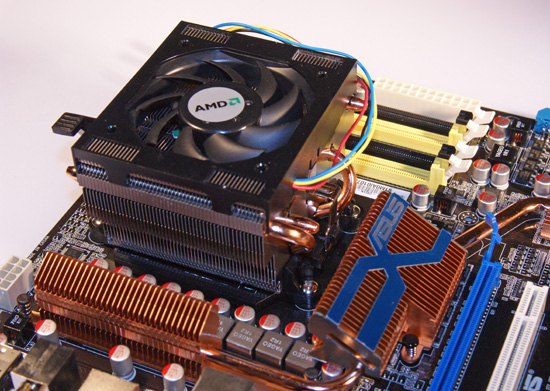
However, the one item mentioned numerous times was the lack of CrossFireX or SLI results compared to a similar Intel based system. True enough, we have not shown any multi-GPU results on an AMD platform in a long time, especially if you discount the Hybrid results on the uATX chipsets. One reason has been the lack of compelling CPU performance on the AMD side to drive a dual or triple card setup. The Phenom tried to take on those duties but with low clock speeds, it failed for the most part. We think the Phenom II will correct those problems or go a long way in addressing them. The staff consensus is that the best option for gamers is to purchase the single highest performing graphics card you can afford for your performance requirements and skip the multi-GPU solutions. This is especially true if you update your system frequently to keep up with the latest games.
Running multi-GPU systems for gaming has other potential negatives ranging from additional cooling and power supply requirements to additional GPU costs, and of course game engine support or more importantly, driver support. Multi-GPU systems typically require faster processors and system memory to reduce bottlenecks in the rendering/data pipelines. In addition, running a high-end CrossFire or SLI solution at resolutions below 1920x1200 is pretty much a waste of resources in most cases, so monitor cost also comes into play.
That short summary sounds like a typical economic report right now; it’s all bad and gloomy. Do not get us wrong, there is a market for CrossFire/SLI based gaming systems. Just go to the NVIDIA or AMD websites if you do not believe us. All kidding aside, for those who have the money, benchmark competitively, or want the absolute best gaming experience with all the game details enabled at ultra-high resolutions, then a multi-GPU solution is probably the correct way to go with the right processor choice. One exception is Crysis; we are still waiting for a GPU solution to run that game properly at very high settings with all the eye candy turned on. Who knows, we might even have a solution for that problem in 2010.
In the meantime we will try to answer a few questions today about CrossFire performance with the Phenom II X4 940. Of course, we might raise more questions than we answer. If we do, well, those will have to be answered at some point. Let us discuss the system setup and get to the numbers.
Test Setup
Fortunately for us, during motherboard testing we test SLI or CrossFireX solutions extensively. However, we do not test the graphics cards in the same manner as we do in a GPU review. During motherboard testing, we focus on ensuring compatibility, identifying any layout problems, and checking performance deltas between motherboard chipsets. Instead of running absolute GPU intensive settings, we seek a balance between playable settings, quality, and platform performance. This means reasonable resolutions and 2xAA/8xAF settings to keep the GPU from being a limiting factor where possible. We think these quality settings are fine for most users, especially in FPS games where the differences between 2xAA, 4xAA, or 8xAA are minimized due to the speed of the game.
We run our benchmarks at two of the most popular resolutions for new systems, which happen to be 1680x1050 and 1920x1200. We mention this now as our overview of CrossFireX performance will not have 2560x1600 at 4xAA/16xAF results or tri-card setups. The population of 30” monitors is rather small and except for Crysis, tri-card performance is generally worse than dual card performance with our midrange setups. Consider this review a snapshot of CrossFireX performance with one particular GPU selection as we will not be looking at other ATI cards except the HD4870 1GB.
As such, our test systems today are platform oriented based on similar components and overall pricing schemes between the Intel Core 2 Quad and AMD Phenom II platforms. We selected a “budget” Core i7 setup that is capable of both SLI and CrossFire to ensure platform consistency when we look at SLI performance shortly.
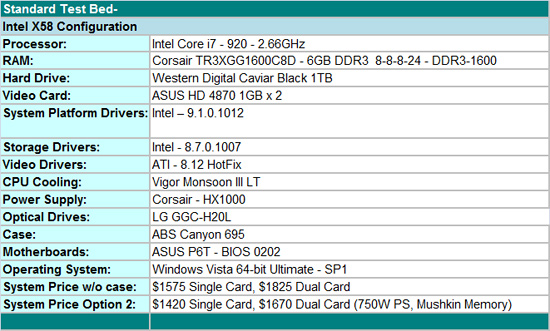
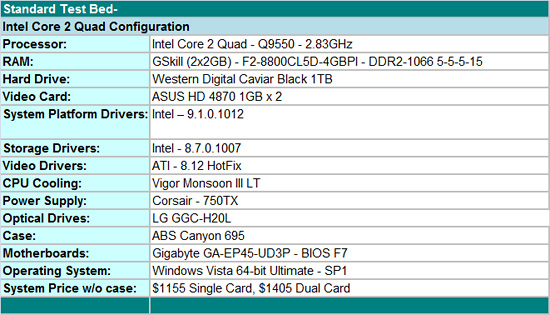
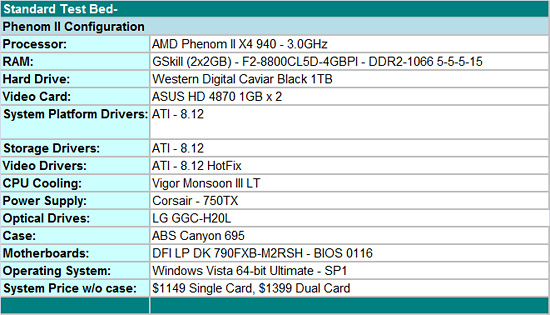
Our Phenom II and Intel Core 2 Quad platforms are within $6 of each other. We fully realize the pricing of the Phenom II X4 940 competes with the Intel Core 2 Quad Q9400, not Q9550, but we are looking at platform costs here. Of course, we could debate the various component choices for several pages and yes, the platform costs could shrink on either side. We did not use rebates in our pricing and all costs were gathered from Newegg on 1/29/09. We think our selections offer the best blend of price, performance, compatibility, and quality right now.
Our decision to go with a 790FX/SB750 combination on the AMD side is strictly based upon performance. The 790FX is about 3%~5% faster on average than comparable 790GX products. AMD continues to recommend the 790GX/SB750 as the platform of choice for the AM2+ and upcoming AM3 products. We disagree from a performance viewpoint; the 790FX/SB750 combination is simply the best choice in our opinion. Of course you will typically pay about $35~$40 or greater for the 790FX boards, but if you intend on running CrossFireX, we think it is worth the additional cost.
On the Intel side, we decided to go with the P45 chipset as it offers a very balanced blend of performance and value. The Gigabyte GA-EP45-UD3P is a superb CrossFire capable motherboard that also happens to be one of the best overclocking S775 products around. The P45 offers dual PCI Express x8 operation in CrossFire mode compared to dual x16 on the 790FX, X48, and X58 boards. However, we did not notice any performance differences between dual x8 and dual x16 operation when comparing the P45 to the X48 in offline testing utilizing our resolutions and quality settings.
The i7 setup can be cost reduced and we did offer a cost improved option by switching out the power supply and memory for equal alternatives. If you are only interested in CrossFire capability on the i7, the motherboard cost can be reduced another $45 and if memory overclocking over DDR3-1800 is not important, then memory costs (DDR3-1600 6GB HP kits) can be reduced another $40 on average. This would bring the i7 platform cost down to $1335 for a single video card configuration without too much of a problem.
Our standard power consumption results with the i7 boards utilized the Corsair HX-1000 power supply and our P45/790FX boards used the Corsair 750W power supply. We are qualifying the Corsair 750TX (and other under 1000W units) on the i7 platform currently. However, we did complete our benchmark runs today on the i7 with the Corsair 750TX. We will provide additional power consumption and temperature results based on these changes shortly.
We selected the ASUS EAH4870 DK/HTDI/1GD5 video card. It is a non-reference design that offers improved thermals and acoustics over the standard HD4870 1GB cards on our board choices. We think if a user is going to run CrossFireX on one of these platforms, then the best possible performance choice is the HD4870 1GB. Depending upon pricing on the HD 4870 1GB cards, a 4870X2 might be a better choice for most users.
The WD Caviar Black 1TB is our hard drive of choice for storage purposes. LG’s Blu-ray playback capable drive fills in for optical duties. We purchased two of G.Skill's impressive DDR2-1100 4GB kits that operate at speeds up to DDR2-1240 on our boards with about 2.1V of VDimm. We used 4GB in our Phenom II and Core 2 Quad systems with memory set at DDR2-1066 with 5-5-5-15 timings at 1.8V. Our DDR3-1600 6GB kit is from Corsair and was dialed in at DDR3-1600 with 8-8-8-24 1T timings at 1.60V. Vigor provided their Monsoon III LT CPU cooler that offers mounting kits for the 1366, 775, and AM2+ processors. ABS provided their Canyon 695 case and it has proved to be exemplary during testing.
Our game selections are a few of the recent top selling titles. Certain titles that are capped at 30FPS like Command and Conquer Red Alert 3 or do not benefit from CrossFireX (Flight Simulator X) were not included. We tested Grand Theft Auto IV with the latest 1.02 patch but still have a couple of unanswered anomalies on the i7 platform. Those results are not available today.
We are also including results with our processors overclocked for CrossFire only. Overclock results with a single card configuration provided little benefit in most cases. Simply overclocking the video cards resulted in better performance numbers than overclocking the processors with this configuration. That is a story for another time. The Phenom II 940 is running at 3.95GHz (17.5x226, DDR2-1205, 5-5-5-18, NB Speed 2486Mhz ), Core 2 Quad Q9550 at 4.25GHz (8.5x500, DDR2-1000, 5-4-4-12), and the Core i7 920 at 4GHz (20x200, DDR3-1600, 8-8-8-24). These were the maximum stable overclocks on air-cooling that we could sustain in a 24/7 setup with Vista Ultimate 64 SP1.
Call of Duty: World at War
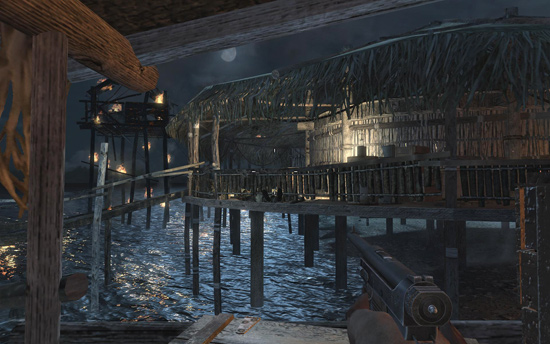
While not our favorite Call of Duty game, World at War certainly improves upon the graphics quality of previous versions. We play through the first few minutes of the Semper FI level by following a repeatable course and capture our performance results with FRAPS. We set the various graphics and texture options to their highest settings with AA at 2x and AF at 8x.
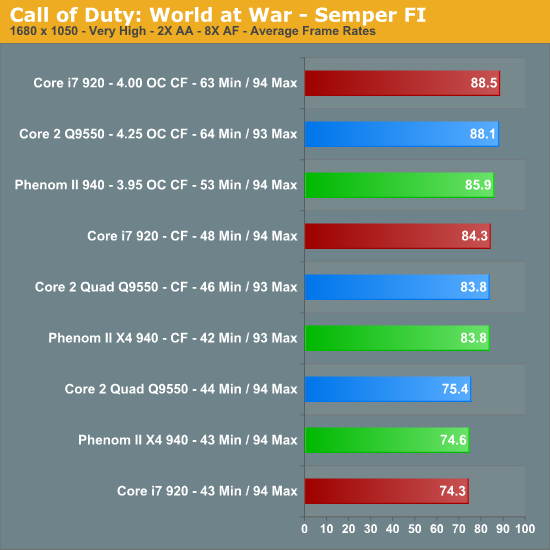
This game is not particularly hard on either the GPU or CPU, but we do hit a hard cap at 94fps. At 1680x1050 the Phenom II platform is able match either Intel platform in single card and CrossFire mode, although minimum frame rates favor Intel slightly. When overclocked, the Phenom II is only about 2% slower in average frame rates but minimum frame rates are 20% lower.
Adding a second card for CrossFire operation improves average frame rates by 12% and minimum frame rates decrease 2% for the Phenom II. The Intel Q9550 has an 11% increase in average frame rates and 4% in minimum frame rates. The Core i7 average frame rates improve by 13% and minimum rates decrease by 12%. Overclocking our processors resulted in a 2%~5% improvement in average frame rates with the Q9550 benefiting the greatest.
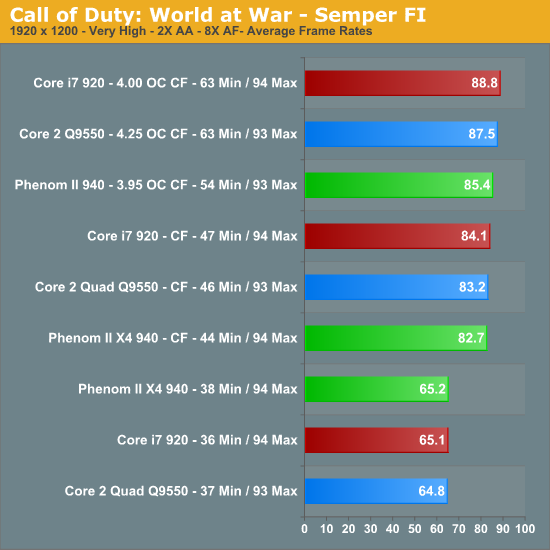
We have roughly the same performance results at 1920x1200 when comparing the platforms. The Phenom II is competitive with the Intel platforms in single card and CrossFire operation, though minimum frame rates in CrossFire mode trail the Intel solutions around 5% on average. Once we overclock the CPUs, the minimum frame rate is about 16% lower on the Phenom II compared to the Intel products.
Installing a second card for CrossFire operation improves average frame rates by 27% and minimum frame rates increase 16% for the Phenom II. The Intel Q9550 has a 28% increase in average frame rates and 24% in minimum frame rates. The Core i7 average frame rates improve by 29% and minimum rates increase by 30%. Overclocking our processors resulted in a 4%~5% improvement in average frame rates with the Q9550 benefiting the most.
We did not notice any difference in game play quality at either resolution between the platforms after playing through several of the levels. Each platform offered a very smooth and fluid gaming experience. We thought the higher minimum frame rates on the Intel systems would be noticeable during the action scenes in the jungle, but we honestly could not tell the systems apart during testing.
Crysis Warhead
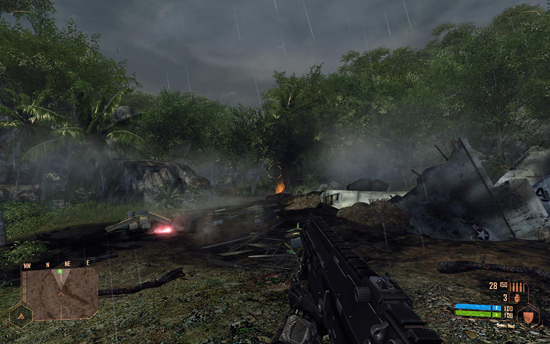
Crysis Warhead is an update to the original game with a storyline that takes place on the other side of the Island during the same time-period as the first. The game features an enhanced and optimized version of the CryEngine 2 but is still a resource monster. We set the graphics options to Gamer, DX10, and 2xAA and play back a timedemo that covers the Ambush level. We have to admit at these settings that the game looks fantastic during action scenes and game play is acceptable.
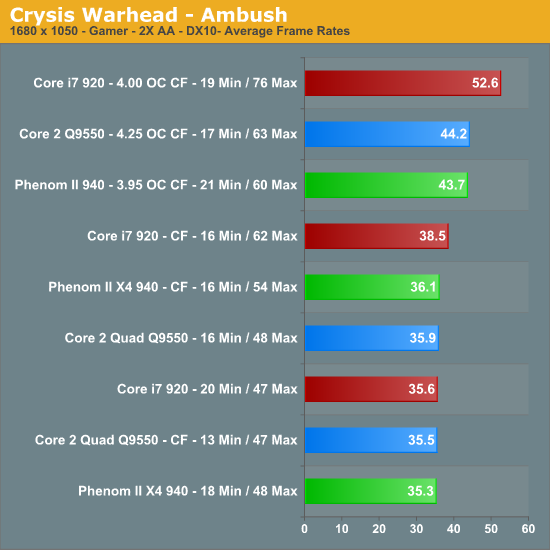
At 1680x1050, all three platforms are clustered together in single card and CrossFire configurations. We also see why a single GPU card can be a better value than a dual GPU solution at this resolution in certain games. It is not until we overclock that we notice some separation between the platforms with the i7 taking a decent lead, but its minimum frame rates do not improve compared to a single card setup. However, our Phenom II setup offers the best minimum frame rates when overclocked and actually offers a slight improvement over its single card scores.
Adding a second card for CrossFire operation improves average frame rates by 2% and minimum frame rates decrease 12% for the Phenom II. The Intel Q9550 has a decrease of 1% in average frame rates and 19% in minimum frame rates. The Core i7 average frame rates improve by 8% and minimum rates decrease by 20%. Overclocking our processors resulted in a 22%~36% improvement in average frame rates with the Core i7 benefiting the greatest.
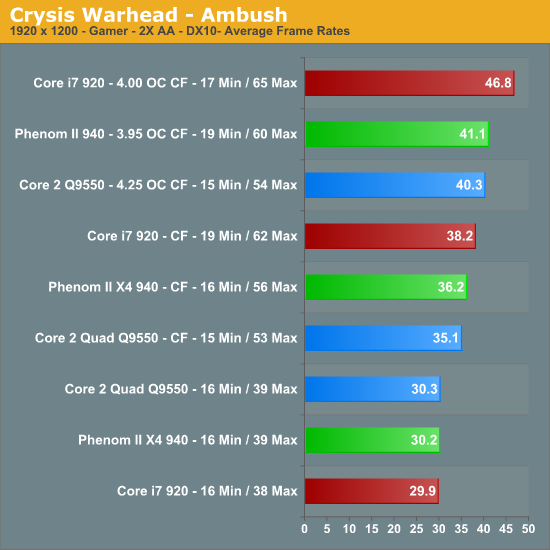
Our 1920x1200 test follows a similar pattern with all three solutions equal in single card testing and CrossFire showing a slight advantage to the i7. The Phenom II is slightly ahead of the Q9550 when overclocked, though it is at a 7% clock speed disadvantage. We have noticed CryEngine 2 will respond to improved memory bandwidth and latencies as we clock up the processors. The i7 holds a 14% advantage in average frame rates while the Phenom II once again impresses us with the best minimum frame rates when overclocked. However, not having a 20fps minimum frame rate is a disappointment with our multi-GPU setups. The NVIDIA 260/285 solutions scale better in SLI than the ATI HD 4870 products. We hope that ATI can improve their drivers for this game.
Adding a second card for CrossFire operation improves average frame rates by 20% but minimum frame rates do not change for the Phenom II. The Intel Q9550 has an improvement of 17% in average frame rates and a decrease of 6% in minimum frame rates. The Core i7 average frame rates improve by 27% and minimum rates increase 18%. Overclocking our processors resulted in a 14%~22% improvement in average frame rates with the Core i7 benefiting the most.
After playing through the several levels on each platform, we thought the Phenom II 940 offered a better overall gaming experience in this title than the Intel Q9550 based on smoother game play. It is difficult to quantify without a video capture, but player movement and weapon control just seemed to be more precise. Of course, if you have the funds, we would recommend the i7 platform for best possible performance.
Fallout 3
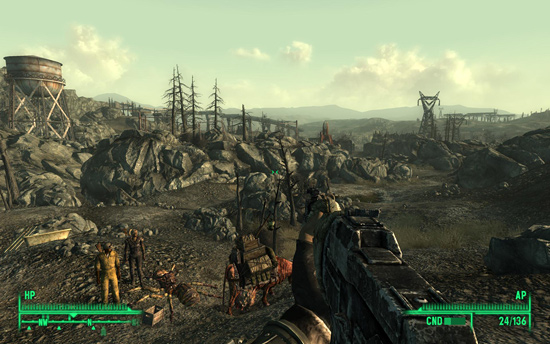
We have played this game numerous times and still have not visited every location on the map or completed all seventy or so side-quests. It could be that the game’s ambiance does not seem to match its predecessors. Alternatively, maybe some of the bugs present that result in NPC characters disappearing have us longing to play Oblivion or KOTR again. Even so, we still love the game. We have moved on to playing the new content pack, Operation: Anchorage, until Dragon Age: Origins ships.
The game engine is based on the one utilized in Oblivion with a few updates, so performance is similar. We set the quality settings to Ultra, AA to 2x, and AF to 8x. Our test consists of following a path back to Megaton and in the process fighting off a couple of Raiders. We utilize FRAPS to capture our results.
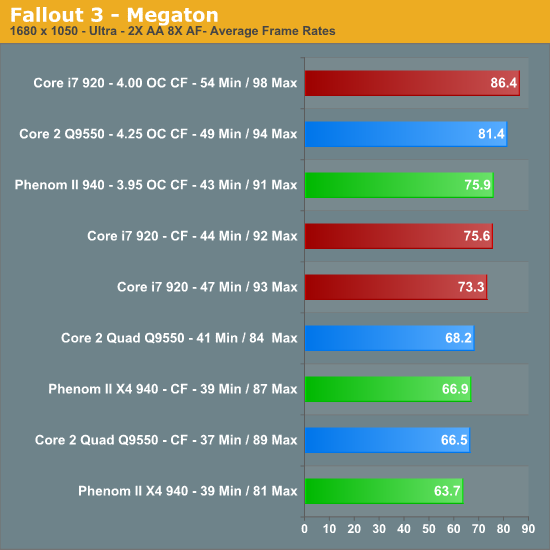
Truthfully, this game does not benchmark well. The game’s level-of-detail mechanism makes constant changes as you cross the map. The LOD adjustments create a seesaw effect in the frame rates and it is difficult to tell if the sudden pause or shudder in frame rates is from the video card or the game engine. That said, the Intel i7 platform simply performs best in this game.
Once again, in our single card testing at 1680x1050 each setup is very close with the Intel Q9550 holding a 4% advantage in average frame rates over the Phenom II 940. The Phenom II posts slightly better minimum frame rates once again. In CrossFire testing the Q9550 holds a small 1% advantage, close to our error of margin. The Q9550 picks up some steam when overclocked and holds an 8% advantage over the Phenom II 940 in average frame rates and 13% in minimum frame rates with a 7% clock speed advantage. The i7 leads our two competitors in overclocked CrossFire performance by 6% and 13% respectfully.
Adding a second card for CrossFire operation improves average frame rates by 4% and minimum frame rates stay the same for the Phenom II. The Intel Q9550 has an improvement of 2% in average frame rates and 11% in minimum frame rates. The Core i7 average frame rates improve by 3% and minimum rates decrease by 7%. Overclocking our processors resulted in a 14%~19% improvement in average frame rates with the Q9550 benefiting the most.
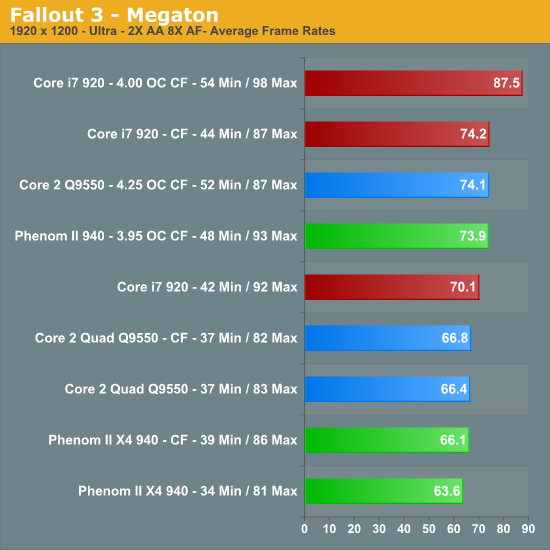
The 1920x1200 results are similar with the Q9550 and Phenom II 940 scoring nearly the same in single card and CrossFire. We just do not see any real benefits in having CrossFire at stock speeds with the Q9550 or Phenom II 940. Once we overclocked each processor, we noticed an 11% increase in CrossFire performance on these two platforms. The Q9550 holds a slight advantage in minimum frame rates with CrossFire when overclocked while the Phenom II 940 leads at stock clock speeds.
Adding a second card for CrossFire operation improves average frame rates by 4% and minimum frame rates by 15% for the Phenom II. The Intel Q9550 has an improvement of less than 1% in average frame rates and no changes in minimum frame rates. The Core i7 average frame rates improve by 6% and minimum rates increase 5%. Overclocking our processors resulted in a 12%~17% improvement in average frame rates with the Core i7 benefiting the most.
Our Core i7 scores better with a single card setup than the other two platforms with CrossFire. The same holds true with the stock i7 CrossFire results scoring higher than our two overclocked competitors do. Overclocking the i7 CrossFire setup results in a 17% increase in average frame rates that required a 50% increase in core clock speeds.
As far as game play experiences, we noted no differences between the Intel Q9550 and Phenom II 940 platforms. Each one offered a very good experience with minimum frame rates on each platform being acceptable. The amount of LOD adjustments in the game was disconcerting at times . When we experienced them, the game stutter was minimized on the i7 setup compared to the other two platforms with CrossFire enabled. All three platforms responded in the same manner with a single card setup. Overall, we would not recommend CrossFire for this game at present; even overclocking the processors resulted in a minimum improvement in frame rates.
Far Cry 2
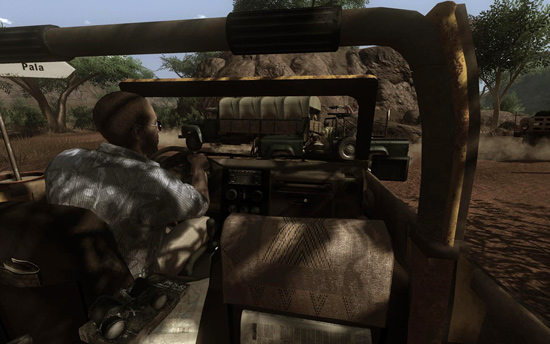
This is another highly awaited title from last year that has beautiful graphics, an open ended environment, and is fun to play... but the traveling between missions tends to get repetitive. If you dial up the graphics options, the game rewards with you some fantastic visuals courtesy of the Dunia Engine. The game also features the most impressive benchmark tool we have seen in a PC game. We set the performance feature set to Very High, graphics to High, and enable DX10 with AA set to 2x. The in-game benchmark tool is utilized with the Ranch Small level.
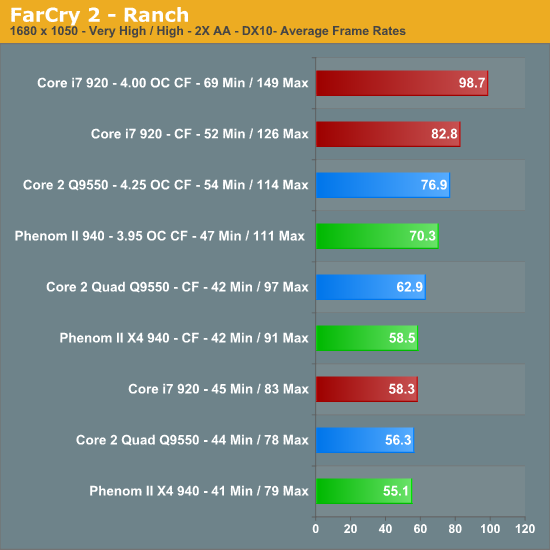
We learned two things about this game. It favors the Intel platforms, and once you provide enough GPU horsepower, the i7 is untouchable. This is especially true once the i7 is overclocked. Although not shown, our single card results with the i7 at 4.00GHz resulted in an average frame rate of 68.8 with the minimum at 54.2 and maximum at 106.2. Single card results with the Q9550 and Phenom II 940 overclocked only increased frame rates by 1fps. If you wanted to pick a single benchmark and show a large disparity in gaming performance between the Intel and AMD platforms, this is the one to use. We would highly suggest to AMD that they send an engineer to UbiSoft for game engine optimizations.
In the 1680x1050 single card tests, the Intel platforms are slightly ahead of the AMD setup; even minimum frame rates favor Intel in this game. Enable CrossFire and we see the Q9550 leading the Phenom II 940 by 7% with minimum frame rates being equal. The i7 CrossFire results are impressive with a 31% frame rate increase over the Q9550 and 41% over the Phenom II 940. Once we overclock our processors, scores improve for the Q9550 and Phenom II 940 with frame rates increasing 22% and 20% over stock CF numbers respectively. The i7 shows a similar 19% increase when overclocked. Even though the Q9550 has a 7% clock speed advantage over the Phenom II 940, frame rates improve by 17% in the overclocked CrossFire results.
Adding a second card for CrossFire operation improves average frame rates by 5% and minimum frame rates less than 1% for the Phenom II. The Intel Q9550 has an improvement of 12% in average frame rates and minimum frame rates actually decrease by 5%. The Core i7 average frame rates improve by 42% and minimum rates increase 15%. Overclocking our processors resulted in an 19%~22% average improvement in average frame rates with the Q9550 benefiting the most.
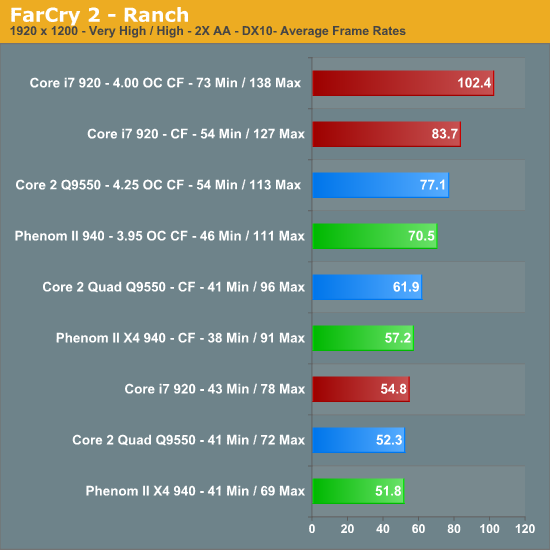
At 1920x1200, the benchmarks reveal nothing new between the platforms. The Phenom II 940 is competitive with a single card, trails the Q9550 by 8% in CrossFire and 9% when overclocked, even though we start to become CPU/GPU limited on these two platforms. The Q9550 does hold a 17% advantage in minimum frame rates in the overclocked tests. The i7 is just stupid fast compared to our other two platforms with its standard CrossFire results being 8% and 18% faster than the overclocked Q9550 and Phenom II 940 processors respectively. Overclocking the i7 puts it in another league altogether.
Adding a second card for CrossFire operation improves average frame rates by 12% and minimum frame rates decrease by 8% for the Phenom II. The Intel Q9550 has an improvement of 18% in average frame rates and minimum frame rates do not change. The Core i7 average frame rates improve by 53% and minimum rates increase 26%. Overclocking our processors resulted in a 22%~26% average improvement in average frame rates with the Q9550 benefiting the greatest.
When it comes to game play experience and not benchmark tests, all three platforms responded the same at our specified settings. We did not notice any advantages with the improved frame rates that the i7 offers over the other two platforms. However, with the i7 we could change the graphic settings to Very High and increase AA to 4x and still experience very good game play. It was as if nothing changed except now we were looking at the savannahs of Africa in a much better way. These same settings were not always a pleasant experience on the other two platforms during heavy action scenes, but the game remained playable for the most part.
Left 4 Dead
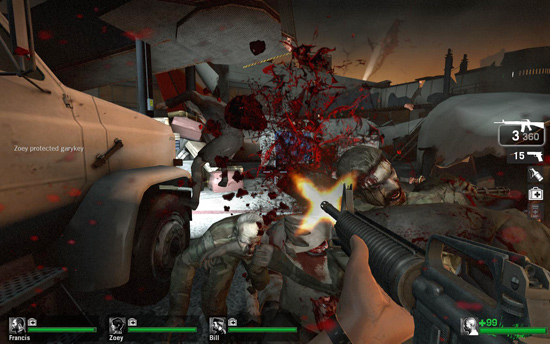
This game is a blast and addictive to boot - provided you like killing hundreds of zombies while trying to take care of your teammates and sustaining high blood pressure rates. What we really like about Source engine games is their ability to run well on variety of systems. We enable all options, set AA to 2x and AF to 8x, and play back a custom timedemo of a complete game session from the Runway chapter within the Dead Air campaign.
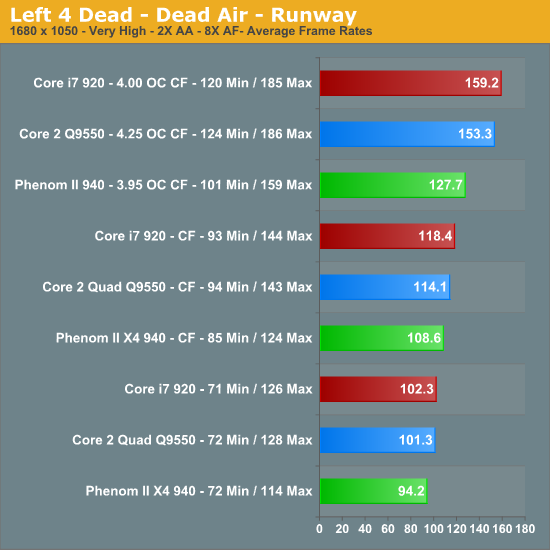
This title also favors the Intel platforms. When comparing the Q9550 to the Phenom II 940 at 1680x1050 it holds a 7% average frame rate advantage in single card mode, 5% in Crossfire, and 20% in the overclocked settings even though the Q9550 only has a 7% clock speed advantage. Minimum frame rates for the Phenom II remain very competitive against the Q9550 until the processors are overclocked, but a 101fps minimum is still outstanding. The i7 continues to dominate the other two solutions in benchmark results.
Adding a second card for CrossFire operation improves average frame rates by 15% and minimum frame rates by 18% for the Phenom II. The Intel Q9550 has an improvement of 13% in average frame rates and 30% in minimum frame rates. The Core i7 average frame rates improve by 16% and minimum rates increase 31%. Overclocking our processors resulted in an 17%~34% average improvement in average frame rates with the Core i7 benefiting the most.
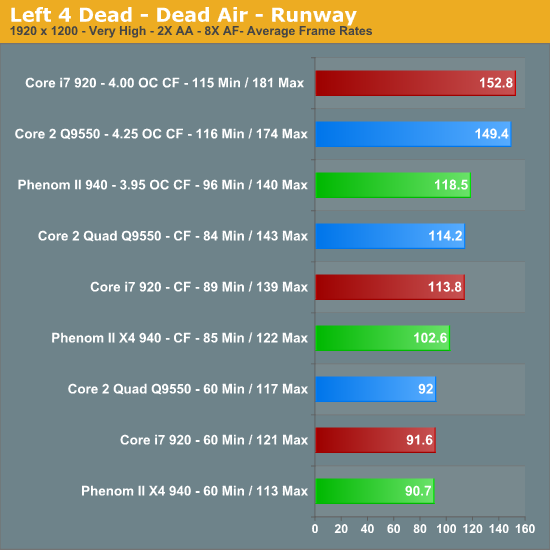
No surprises here; the 1920x1200 results follow the pattern set at 1680x1050. All three solutions bunch together in the single card results and then spread out as we introduce CrossFire and overclocking into our equation. The Q9550 holds a 10% advantage over the Phenom II in CrossFire and 26% when overclocked. Minimum frame rates continue to be very good for the Phenom II in single card and CrossFire operation.
The Q9550 scores slightly better than the i7 in the single card and CrossFire mode as its 6% advantage in clock speeds (or perhaps the larger L2 cache) comes into play as we start to become more GPU limited at this resolution. The Phenom II has a 6% clock speed advantage over the Q9550 and a 12% advantage over the i7 that leads us to believe platform efficiency is a problem or the game engine optimizations favor Intel. We believe it is a combination of both.
Adding a second card for CrossFire operation improves average frame rates by 13% and minimum frame rates by 42% for the Phenom II. The Intel Q9550 has an improvement of 24% in average frame rates and 40% in minimum frame rates. The Core i7 average frame rates improve by 24% and minimum rates increase 48%. Overclocking our processors resulted in a 16%~34% average improvement in average frame rates with the Core i7 benefiting the greatest.
Our game play experiences revealed no differences between the three platforms. Although the frame rates were lower with the Phenom II, it just did not matter in this game as minimum frame rates were at 60fps or higher in our tests.
Race Driver: GRID
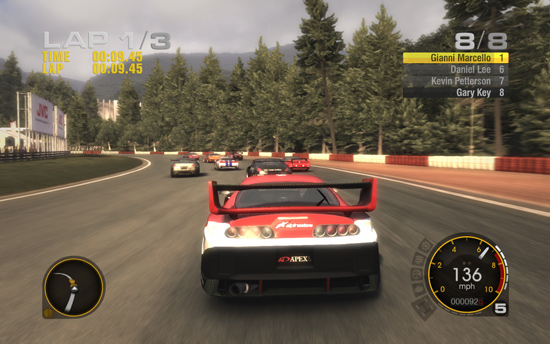
The more serious racing fans on the staff tend to end up at iRacing.com or playing a modified version of Grand Prix Legends for our racing simulation fix. However, there comes a time to throw out physics and just have some fun. In that case, GRID is the game we play. We turn up all the options, set AA to 2x, and let the rubber burn in a Race Day event. Our results are captured via FRAPS.
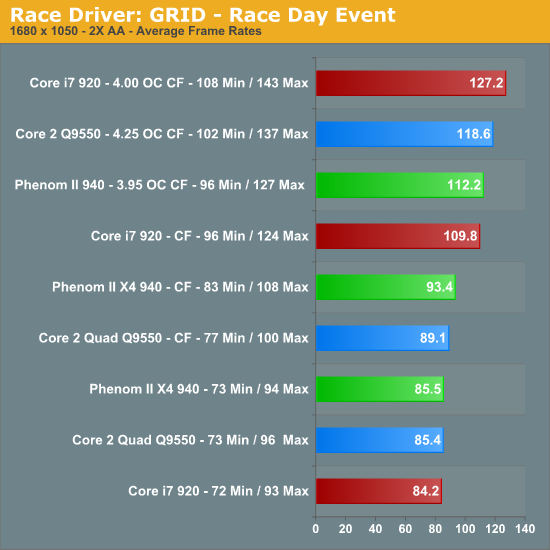
At 1680x1050 in single card mode, we are GPU limited. All three platforms have close scores, but the Phenom II 940 does get a win here. The Phenom II leads the Q9550 by 4% in CrossFire average frame rates and 7% in minimum frame rates. The tables are reversed once we overclock the processors as the Q9550 has a 5% advantage in average frame rates and 6% in minimum frame rates, both close to the 7% clock speed advantage for the Q9550. The i7 runs like a Ferrari once we introduce CrossFire and overclocking into the benchmarks as it easily surpasses the other two platforms.
Adding a second card for CrossFire operation improves average frame rates by 21% and minimum frame rates by 25% for the Phenom II. The Intel Q9550 has an improvement of 19% in average frame rates and 25% in minimum frame rates. The Core i7 average frame rates improve by 42% and minimum rates increase 44%. Overclocking our processors resulted in an 18%~30% average improvement in average frame rates with the Q9550 benefiting the most.
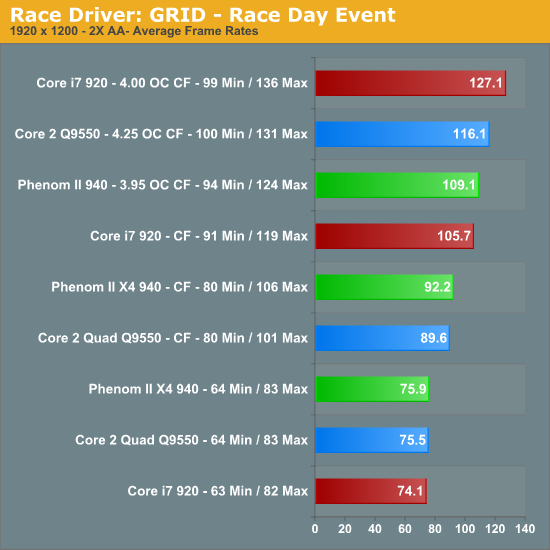
Turning the resolution up to 1920x1200 has us playing the same old record. The results follow the pattern set at 1680x1050. The Phenom II scores another win here in single card and CrossFire mode over the Q9550. The Core i7 continues to dominate the benchmarks although the Phenom II continues to make a very good showing in minimum frame rates.
Adding a second card for CrossFire operation improves average frame rates by 9% and minimum frame rates by 14% for the Phenom II. The Intel Q9550 has an improvement of 5% in average frame rates and 5% in minimum frame rates. The Core i7 average frame rates improve by 30% and minimum rates increase 33%. Overclocking our processors resulted in an 18%~32% average improvement in frame rates for our collective group with the Q9550 benefiting the most.
Once again, our game play experience indicates there is no difference between the three platforms at our settings. Although frame rates were higher with the i7 in CrossFire mode, there was no appreciable difference in game play quality.
Company of Heroes: Opposing Fronts
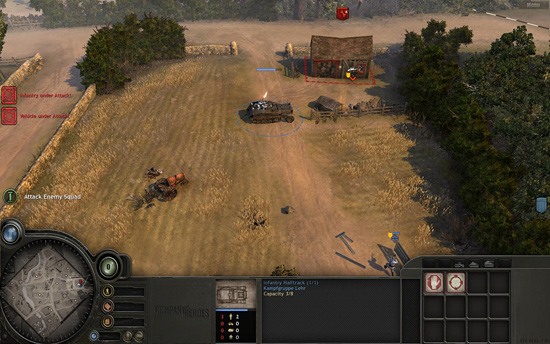
The oldest title in our test suite is still the most played. CoH has aged like fine wine and we still find it to be one of the best RTS games on the market. We look forward to the Tales of Valor standalone expansion pack this spring. In the meantime, we crank all the options up to their highest settings, enable AA at 2x, and run the game under DX9. The DX10 patch offers some improved visuals but with a premium penalty in frame rates. We track a custom replay of Able Company’s assault at Omaha Beach with FRAPS.
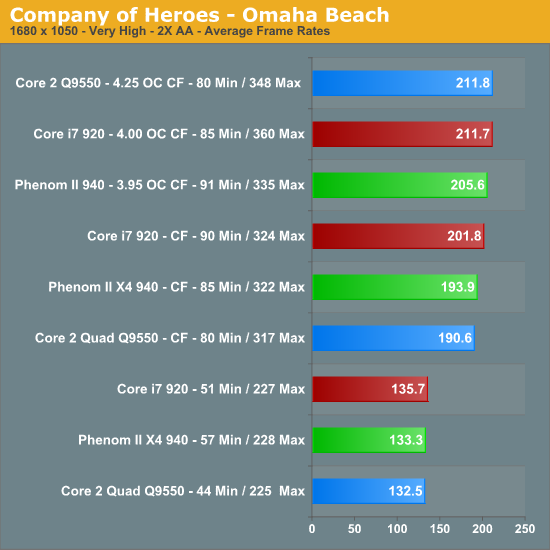
Just like our previous test results, we have very similar single card scores at 1680x1050. In this particular game, the Phenom II X4 940 offers the best minimum frame rates in each benchmark when compared to the Q9550 and surpasses the i7 in two tests. Only when the platform is overclocked do we see the Q9550 ahead of the Phenom II in average frame rates, a small 3% to be exact. However, the Phenom II has a 13% advantage in minimum frame rates.
Adding a second card for CrossFire operation improves average frame rates by 45% and minimum frame rates by 49% for the Phenom II. The Intel Q9550 has an improvement of 44% in the average and 81% in minimum frame rates. The Core i7 average frame rates improve by 48% and minimum rates increase 76%. Overclocking our processors resulted in a 5% average improvement in frame rates for our collective group, indicating we are largely GPU limited.
During testing, the Intel systems would generate minimum frame rates in the 23~24fps range on a couple of runs and then jump to their current results on the others. We noticed this in game play also; the Intel systems would hitch and pause at times. We would shutdown the game, clear the prefetch folder, and reboot. The game would operate fine in the next series of testing, though we still had stuttering in intensive ground scenes at times. We tried new images, different CPUs, memory changes, and the Sapphire HD 4870 cards with the same results. The Phenom II 940 had extremely stable frame rates in each test and action was very fluid during game play.
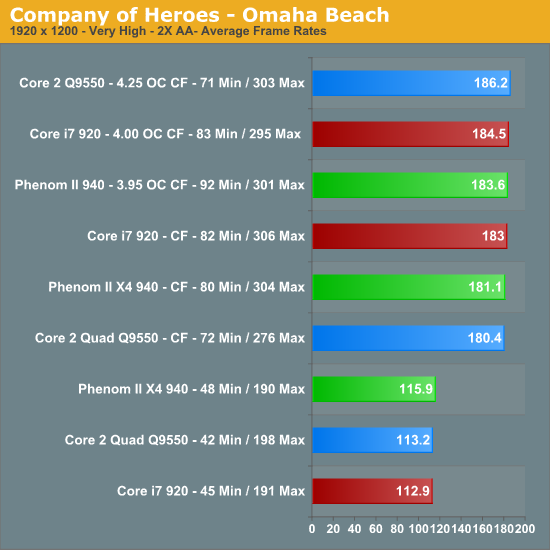
Lather, rinse, and repeat: the 1920x1200 numbers follow the same performance pattern once again - not that we expected anything different. Nevertheless, it is getting boring mentioning that same fact on every page. In single card testing the Phenom II 940 is 2% faster in average frame rates and 14% ahead in minimum frame rates compared to the Q9550. CrossFire results barely favor the Phenom II in average frame rates while minimum frame rates are about 8% better than the Q9550.
The i7 shows its strength in CrossFire testing in both average and minimum frame rates. We only experienced the previously mentioned drop in minimum frame rates a couple of times with i7 but it was still noticeable. The Q9550 finishes first again in average frame rates when overclocked but falls about 29% behind the Phenom II 940 in minimum frame rates.
Adding a second card for CrossFire operation improves average frame rates by 57% and minimum frame rates by 66% for the Phenom II. The Intel Q9550 has an improvement of 59% in the average and 71% in the minimum frame rates. The Core i7 average frame rates improve by 62% and minimum rates increase 82%. Overclocking our processors only improved frame rates 2% on average as we continue to be GPU bound at this resolution.
Now that we have discussed the numbers, what about the game play experience? As we alluded to earlier, the Intel platforms had problems with minimum frame rates throughout testing - not just in the benchmarks, but also during game play in various levels and online. We have not nailed it down yet, but we have noticed this problem consistently. In contrast, the Phenom II X4 940 had rock solid frame rates and offered the smoothest game play experience. The problem is very likely driver related in some manner (as the man who helped to start DirectX once put it, "the drivers are always broken"), but nevertheless this is an issue on the two Intel platforms.
Final Words
We set out to answer the question, “Is the Phenom II competitive with a similar Intel Platform in CrossFireX?” Based on our results today, we would have to answer a resounding yes to that question.
It’s not as balanced as the Core i7 920 or even Core 2 Quad Q9550 in a few games, but it does not embarrass itself either. In fact, we think it put up a very good fight and stood its ground with the Q9550. Compared directly to the Q9550, the Phenom II X4 940 is a strong competitor. It had better average frame rates in CrossFire mode than the Q9550 in three titles, tied in one, and finished behind the Q9550 by about 2%~7% in the other three games.
When it came to actual game play experiences, we thought the Phenom II 940 was clearly the better choice in Company of Heroes: Opposing Fronts and Crysis Warhead due to minimum frame rate advantages and fluidity of game play. In the five other titles, we could not tell any real differences in the quality of game play between the Phenom II 940 and Core 2 Quad Q9550. Except for Far Cry 2 where we could raise the graphic quality settings without affecting game play, the i7 platform was no different than our two other solutions.
However, looking through the performance results and game play experiences, we have to mention just how fast Intel's Core i7 is right now. Its results were just remarkable in Far Cry 2 and it consistently scored at the top in CrossFire mode in the other games even though it has the lowest core clock speed. If platform pricing were better, then the Core i7 series would have a clear recommendation for an upgrade if you were considering a multi-GPU setup.
As it stands now, if you already have a CrossFire capable motherboard, there is no need to change architectures with the current crop of AMD video cards - or you can just forget about "CrossFire compatible" altogether and grab a 4870X2. If you are currently running a P45 or X48 chipset then stick with that platform. We would highly suggest an E8500 or up dual-core or a Q9550 or up quad-core processor in order to gain any benefits from CrossFire on the Intel side. The same theory holds true on the AMD side. If you have an AM2+ motherboard based on the 790GX or 790FX chipset then stick with it and get a Phenom II X4 940.
Despite Intel's advantages in processor technology and developer relations, AMD was able to perform well in a CrossFireX setup today. In fact, it did much better than expected when we started looking at multi-GPU gaming results after the Phenom II launch. The real question is if a multi-GPU setup has enough benefits to justify the cost, regardless of platform. This is something Derek is investigating currently. In the meantime, we just know that it is no longer embarrassing to run CrossFire on an AMD processor based system. What about NVIDIA and SLI? Well, that's a question for another day....







